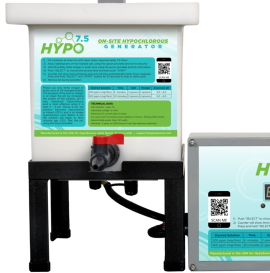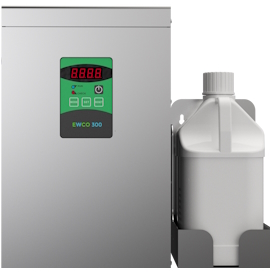Исследование > Поиск термина: "Produce"
Часто используемые названия для растворов хлорноватистой кислоты
- Electrolytically Generated Hypochlorous Acid
- Neutral Electrolyzed Water (NEW)
- Electrolyzed Oxidizing Water (EOW)
- Electro-chemically Activated Water (ECA)
- Super-oxidized water (SOW)
Результаты: 128 опубликованные статьи

Microbe(s): Total Microbial Count

Microbe(s): Escherichia coli O157:H7, Listeria monocytogenes

Microbe(s): Listeria monocytogenes, Escherichia coli, Vibrio parahaemolyticus

Microbe(s): Total Microbial Count

Microbe(s): Total Microbial Count, Fungi, Yeast, Mold

Microbe(s): Total Microbial Count

Microbe(s): Multiple

Microbe(s): Listeria monocytogenes, Salmonella enterica

Microbe(s): All

Microbe(s): Staphylococcus aureus

Microbe(s): Bacillus cereus

Microbe(s): Colletotrichum fructicola

Microbe(s): Escherichia coli O157:H7, Salmonella Typhimurium

Microbe(s): Total Microbial Count, Fungi, Yeast, Mold

Microbe(s): Total Microbial Count

Microbe(s): Total Microbial Count

Microbe(s): Escherichia coli O157:H7, Salmonella Typhimurium

Microbe(s): Total Microbial Count, Listeria

Microbe(s): Staphylococcus aureus, Bacillus cereus, Escherichia coli, Aspergillus fumigatus

Microbe(s): Listeria monocytogenes

Microbe(s): None

Microbe(s): Dioscorea spp.

Microbe(s): Multiple

Microbe(s): Aspergillus flavus, A. parasiticus, A. nomius, RE: Aflatoxin

Microbe(s): Total Microbial Count, RE: Nitrite

Microbe(s): Escherichia coli

Microbe(s): Salmonella

Microbe(s): Campylobacter

Microbe(s): Pseudomonas spp.

Microbe(s): Escherichia coli O157:H7

Microbe(s): Total Microbial Count, Escherichia coli O157:H7, Listeria monocytogenes, Pseudomonas spp., Fungi, Yeast

Microbe(s): MNV-1, Norovirus, HAV, Hepatitis A

Microbe(s): Escherichia coli, Vibrio parahaemolyticus

Microbe(s): Penicillium digitatum, Pseudomonas spp.

Microbe(s): Total Microbial Count

Microbe(s): Total Microbial Count, Fungi, Yeasts

Microbe(s): Total Microbial Count

Microbe(s): Escherichia coli O157:H7

Microbe(s): Total Microbial Count, Fungi, Yeasts

Microbe(s): Escherichia coli O157:H7

Microbe(s): Escherichia coli O157:H7

Microbe(s): Escherichia coli O157:H7

Microbe(s): Fusarium sp.

Microbe(s): Staphylococcus epidermidis

Microbe(s): Escherichia coli O157:H7, Listeria monocytogenes

Microbe(s): Escherichia coli O157:H7, Listeria monocytogenes

Microbe(s): E. coli O157:H7

Microbe(s): Listeria monocytogenes

Microbe(s): Escherichia coli O157:H7, Listeria monocytogenes

Microbe(s): Escherichia coli, Listeria innocua

Microbe(s): Phytophthora parasitica var. nicotianae

Microbe(s): Total Microbial Count

Microbe(s): Escherichia coli O157:H7, Salmonella enteritidis

Microbe(s): Total Microbial Count, Fungi, Yeast, Mold

Microbe(s): Escherichia coli, Salmonella

Microbe(s): Escherichia coli O157:H7

Microbe(s): Escherichia coli O157:H7, Listeria monocytogenes

Microbe(s): Escherichia coli, Bacillus subtilis

Microbe(s): Total Microbial Count

Microbe(s): Total Microbial Count

Microbe(s): Listeria monocytogenes

Microbe(s): Salmonella enterica, Escherichia coli O157:H7, Listeria monocytogenes

Microbe(s): Total Microbial Count

Microbe(s): Escherichia coli O157:H7, Listeria monocytogenes, Salmonella Typhimurium, Bacillus cereus

Microbe(s): Botrytis cinerea, Monilinia fructicola

Microbe(s): Total Microbial Count

Microbe(s): Escherichia coli, Listeria innocua, Salmonella choleraesuis

Microbe(s): Escherichia coli, Salmonella spp.

Microbe(s): Escherichia coli O157:H7, Salmonella enteritidis

Microbe(s): Escherichia coli O157:H7, Listeria monocytogenes, Staphylococcus aureus, Salmonella Typhimurium

Microbe(s): Escherichia coli O157:H7, Listeria monocytogenes

Microbe(s): Total Microbial Count

Microbe(s): Salmonella Enteritidis, Escherichia coli, Staphylococcus aureus, Listeria monocytogenes, and Bacillus cereus

Microbe(s): Salmonella spp., Escherichia coli

Microbe(s): Total Microbial Count

Microbe(s): Fungi, Penicillium digitatum

Microbe(s): Fungi, Botrytis cinerea, Monilina fructicola

Microbe(s): Escherichia coli O157:H7

Microbe(s): Listeria monocytogenes, Escherichia coli O157 : H7

Microbe(s): Multiple

Microbe(s): Total Microbial Count

Microbe(s): Escherichia coli O157:H7

Microbe(s): Escherichia coli O157:H7

Microbe(s): Escherichia coli O157:H7, Salmonella typhimurium, Listeria monocytogenes

Microbe(s): Total Microbial Count

Microbe(s): Escherichia coli, Salmonella typhimurium, Staphylococcus aureus, Listeria monocytogenes, and Enterococcus faecalis

Microbe(s): Escherichia coli O157:H7, Salmonella Typhimurium, Listeria monocytogenes

Microbe(s): Multiple

Microbe(s): Salmonella, Listeria monocytogenes, Escherichia coli O157:H7, Erwinia carotovora

Microbe(s): Escherichia coli O157:H7, Salmonella, and Listeria monocytogenes

Microbe(s): Escherichia coli O157:H7, Listeria monocytogenes

Microbe(s): Escherichia coli O157:H7, Salmonella spp., Listeria monocytogenes

Microbe(s): Listeria monocytogenes

Microbe(s): Escherichia coli

Microbe(s): Fungi, Penicillium expansum

Microbe(s): Pseudomonas fluorescens, Pantoea agglomerans or Rahnella aquatilis

Microbe(s): Total Microbial Count

Microbe(s): Listeria monocytogenes

Microbe(s): Listeria monocytogenes

Microbe(s): Salmonella Enteritidis, Listeria monocytogenes

Microbe(s): Multiple

Microbe(s): Escherichia coli O157:H7, Salmonella

Microbe(s): Listeria monocytogenes, Escherichia coli O157:H7

Microbe(s): Total Microbial Count

Microbe(s): Total Microbial Count

Microbe(s): Fungi, Penicillium expansum

Microbe(s): Escherichia coli O157:H7, Salmonella enterica, Listeria monocytogenes

Microbe(s): Salmonella

Microbe(s): Total Microbial Count

Microbe(s): Escherichia coli O157: H7, Salmonella Enteritidis, Listeria monocytogenes

Microbe(s): Salmonella enterica

Microbe(s): Escherichia coli O157: H7, Salmonella Enteritidis, and Listeria monocytogenes

Microbe(s): Salmonella enteritidis, Listeria monocytogenes

Microbe(s): Total Microbial Count

Microbe(s): Total Microbial Count

Microbe(s): Botryosphaeria berengeriana

Microbe(s): Total Microbial Count

Microbe(s): Staphylococcus, Staphylococcal enterotoxin-A

Microbe(s): Escherichia coli O157: H7

Microbe(s): Total Microbial Count, Coliforms, Bacillus cereus

Microbe(s): Fungi

Microbe(s): Escherichia coli O157:H7, Listeria monocytogenes

Microbe(s): Total Microbial Count

Microbe(s): Escherichia coli O157:H7, Listeria monocytogenes

Microbe(s): Total Microbial Count

Microbe(s): Total Microbial Count

Microbe(s): Tilletia indica

Microbe(s): Total Microbial Count
Best Hypochlorous Acid (HOCL) Generators
 Portable Hypochlorous Acid (HOCL) Machine
Portable Hypochlorous Acid (HOCL) Machine
Make high quality hypochlorous acid in the home or office.
$159.99 + Free Shipping
 HOCL Machine + Electrostatic Sprayer
HOCL Machine + Electrostatic Sprayer
Make hypochlorous acid and spray with an electrostatic cold fogger.
$309.98 + Free Shipping


